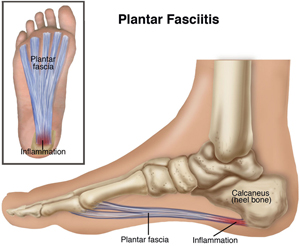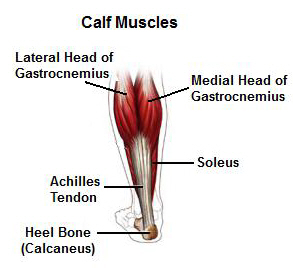Causes
Plantar fasciitis may be the most common cause of heel or bottom of foot pain. It is common among runners and athletes due to the repetitive stress on the feet with running, sprinting and jumping. It may also occur after wearing footwear with inadequate support, or when you have a change in daily tasks (e.g. starting a new job where you’re on your feet most of the day when you were previously at a desk job with mostly sitting). It may also be a side effect of tight calf muscles or Achilles tendon as this would create greater pull on the heel bone. Wearing high heel shoes can be a factor in the development of plantar fasciitis. Those with either particularly high arches or particularly flat feet may also be at greater risk for developing plantar fasciitis. Whatever the case may be, the repeated stress and strain on the plantar fascia causes an inflammation of the fascia itself.
Symptoms
Pain in the heel or bottom of the foot is the major symptom of plantar fasciitis. It is pain that is usually localized to one spot and is tender to the touch. Pain is likely worse in the morning after the first few steps out bed and eases up as the day goes on. It is important to note here that if the pain is excruciating and you cannot put weight on your foot, it is a good idea to seek out an x-ray or doctor’s assessment to rule out stress fracture. If you are able to bear weight and walking makes it better, it may be more likely that are you are dealing with plantar fasciitis.
Treatment
Treatment is likely to include exercises to loosen the calf muscle and stretch out the plantar fascia. Something simple such as flexing and pointing the feet a number of times before getting out of bed can help.
In the image above, the patient is shown stretching the bottom of the foot. This is done by flexing the foot (and stretching the Achilles tendon) and also flexing the toes. By flexing the toes, this creates a deeper stretch along the bottom of the foot. Anything that stretches out the calf muscles is also a good idea. If stretching alone is just not cutting it, try using a foam roller to roll out your calf muscles and a golf ball or foot roller (which can be found at many dance shops) to help ease the tension on the heel bone (i.e. the calcaneous). You can also see your massage therapist to have them work on that tension.
If you usually wear high heels, try wearing ballet flats or a lower heel until pain subsides. If your shoes are worn out, invest in a more supportive pair. Or if new shoes aren’t in the budget, try using an arch support from the drugstore in your old shoes and see if it makes a difference. Use ice on your heels at the end of the day to try to decrease inflammation. And as usual, come see your physio or RMT for more specific recommendations because being on aching feet all day is not fun.
InSync Physiotherapy is a multi-award winning health clinic helping you in Sports Injuries, Physiotherapy, Exercise Rehabilitation, Massage Therapy, Acupuncture & IMS.



